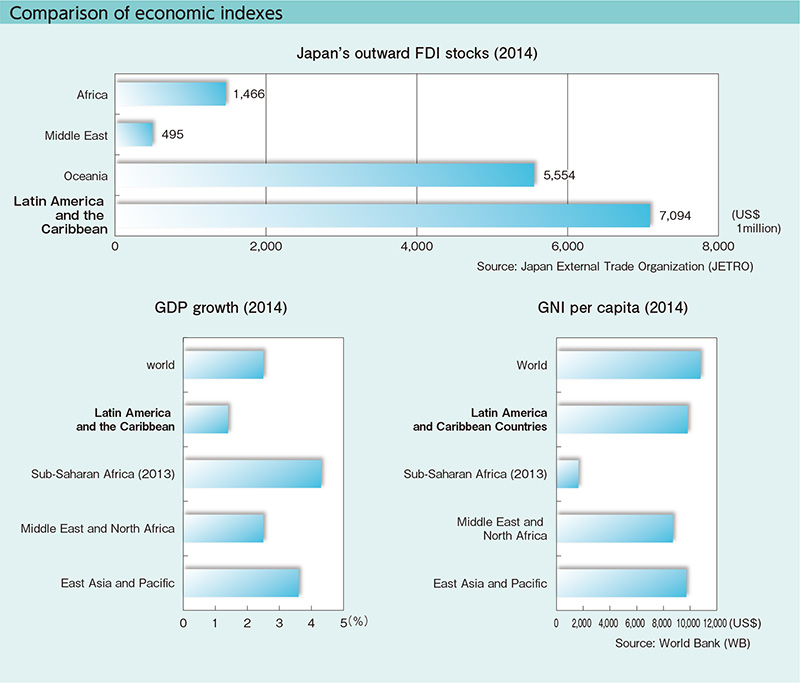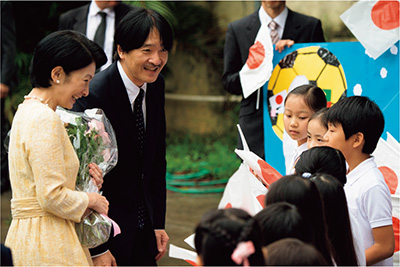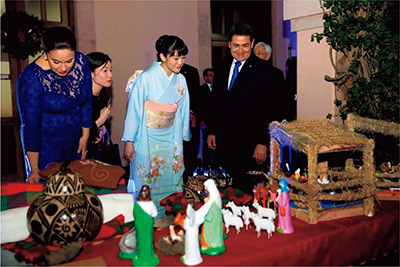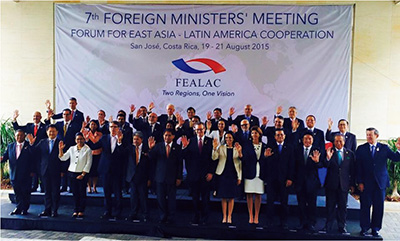Diplomatic Bluebook 2016
Chapter 2
Japan’s Foreign Policy that Takes a Panoramic Perspective of the World Map
1.Strengthening Relations and Cooperating with Latin America and the Caribbean Countries
(1) Strengthening Economic Relations
Latin America and the Caribbean region includes some of the world’s largest economies, such as Brazil (7th largest GDP in the world and a G20 member) and Mexico (14th largest GDP in the world and a G20 member), as well as rapidly growing countries on the Pacific coast such as Colombia, Peru, Chile and Panama. Moreover, there are countries rich in food and mineral resources such as Argentina (a G20 member), Venezuela and Bolivia. There has been an increased attention on economic potential of the region.
The growth of the region’s economy has been slowing down since 2011 due to falling commodity prices and the economic slowdown of major countries outside the region. However, many countries in the region have been steadily growing, still attracting high interest from Japanese companies.
Japan places importance on the region as an economic partner to grow together, and the Government of Japan has been working in a unified fashion together with the private sector to promote and facilitate trade and investment relations between Japan and the region. Specifically, the Government organized the 2nd Japan-SICA Business Forum in May, and the 1st Japan-Cuba Joint Public-Private Committee Meeting which was held in November as a follow-up to Foreign Minister Kishida’s visit to Cuba. Moreover, the Government of Japan is making efforts to strengthen economic relations, including promotion of Japanese companies’ expansion into the region, through the promotion of establishment of EPAs, legal frameworks such as investment treaties and consultations based on such frameworks which contribute to trade acceleration and the improvement of the business environment for companies operating in the region as well as consultations based on those frameworks. Specifically, in 2015 the Investment Agreement between Japan and Uruguay was signed and the Agreement between Japan and Colombia came into force. In January 2016 the Japan-Chile Tax Treaty was signed. Furthermore, the Government of Japan has been negotiating with Colombia for the conclusion of the EPA. Also, commemorating the 10th Anniversary of entry into force of the Japan-Mexico EPA, the Governments of Japan and Mexico organized the EPA 10th Anniversary Seminar and the 8th Mexico Business Environment Committee, continuing talks on reinforcing the bilateral economic ties. As a result of these efforts, the number of Japanese enterprises conducting business in the Latin America and the Caribbean region reached 2,087 as of October 2014.

In January 2016, the Consulate-General of Japan was newly established in Leon, Mexico, reinforcing the back-up structure for Japanese companies that develop business in the region.
(2) Strengthening People-to-people exchange
The year 2015 marked the 120th anniversary of the establishment of diplomatic relations between Japan and Brazil. Commemorating this anniversary, Their Imperial Highnesses Prince and Princess Akishino visited Brazil from October to November and met with President Dilma Rousseff and other dignitaries as well as communicating with Japanese descendants in different places. The year 2015 also marked the 80th anniversary of the establishment of diplomatic relations between Japan and the five states of Central America (Guatemala, El Salvador, Honduras, Nicaragua and Costa Rica). Taking the opportunity of the “Japan-SICA Friendship Year” between Japan and the above mentioned five states plus Belize, Panama, and the Dominican Republic, Her Imperial Highness Princess Mako of Akishino visited El Salvador and Honduras in December as Her Imperial Highness’s first formal visit to overseas.
Japan has close human and historical ties with this region, where 2.13 million Japanese descendants live. With this background, the Government of Japan has been strengthening people-to-people exchange with the region. In addition to the above mentioned Prime Minister Abe’s visit to Jamaica and Foreign Minister Kishida’s visit to Cuba, several key figures visited Japan from the Latin America and the Caribbean Region, including Vice-President of the Council of Ministers of Cuba Ricardo Cabrisas in March and November, Bolivian Vice President Álvaro García Linera in April, Honduras President Juan Orlando Hernández and his wife, and Brazil’s Foreign Minister Mauro Vieira in July, Dominica’s Foreign Minister Francine Baron in October, and Uruguayan President Tabaré Vázquez in November (accompanied by Foreign Minister Rodolfo Nin Novoa). In particular, as for the relations with Japanese descendants in the Latin America and the Caribbean Region, the Government of Japan invited young leaders of Japanese descendants in the region, and journalists willing to communicate the appeal of Japan, aiming at promoting cooperation from broader aspects. In addition to the events mentioned above, the government has strengthened exchange at all levels with the region through the invitation of young officials and journalists and various exchange programs. Several exchange programs were held with Brazil and the Central American countries, for which 2015 represented a significant milestone, in particular, the number of commemorative projects with Brazil exceeded 500 in both countries.
 Their Imperial Highnesses Prince and Princess Akishino welcomed by local children (October 28,Brazil; Photo: AFP News)
Their Imperial Highnesses Prince and Princess Akishino welcomed by local children (October 28,Brazil; Photo: AFP News) Her Imperial Highness Princess Mako of Akishino briefed on local crafts from Honduras President Hern?ndez and his spouse (December 8, Honduras; Photo: Honduras President’s Office)
Her Imperial Highness Princess Mako of Akishino briefed on local crafts from Honduras President Hern?ndez and his spouse (December 8, Honduras; Photo: Honduras President’s Office)(3) Contributing to Stable Development of Latin America and the Caribbean Countries
With the recognition that continued growth and political stability are the challenges for stable development of the region, Japan places emphasis on each country achieving stable economic growth through appropriate efforts to reduce poverty and social disparities while at the same time firmly maintaining democracy. From the above perspective, Japan has been providing reliable support through Official Development Assistance (ODA) and other schemes in areas such as the improvement in living standards including education and healthcare as well as renewable energy development and industry infrastructure that may contribute to a sustainable economic growth in the Latin America and the Caribbean region. Furthermore, Japan is promoting so-called triangular cooperation with countries such as Argentina, Chile, Brazil and Mexico, which have reached a stage of providing aid to the third countries thanks in part to the assistance from Japan in the past.
Japan has also cooperated in many aspects of disaster risk reduction with the region, which is vulnerable to natural disasters, including hurricanes and earthquakes. Japan has also actively cooperated in the environmental field as these countries are rich in biodiversity and have deep concern over the increase of natural disasters due to climate change. The Government of Japan provided emergency relief goods to Chile, in response to the damage caused by floods in March, as well as to the Commonwealth of Dominica, which suffered a tremendous loss due to the tropical storm Erika in August. In September, during his visit to Jamaica, Prime Minister Abe announced that Japan had decided to extend a new technical cooperation project in the field of energy efficiency and renewable energy to Jamaica, St. Christopher and Nevis, Trinidad and Tobago and Barbados in response to their requests as one of priority areas for cooperation. It is in line with the “Cooperation towards sustainable development, including overcoming the vulnerabilities particular to small island developing states,” which is the first of the pillars of Japan’s CARICOM policies, presented by Prime Minister Abe at the Japan-CARICOM Summit Meeting held in the previous year.
(4) Cooperation with Latin America and the Caribbean Countries through regional organizations
Various efforts for regional integration have gradually been progressing in the region. In order to strengthen collaboration to address issues in the region and international society, Japan has been strengthening cooperation with the Pacific Alliance, the Forum for East Asia-Latin America Cooperation (FEALAC), the Central American Integration System (SICA), the Caribbean Community (CARICOM), the Union of South American Nations/Union de Naciones Suramericanas (UNASUR), the Common Market of the South/Mercado Comun del Sur (MERCOSUR), and other local organizations. In particular, the economic ties between Japan and SICA were further reinforced in the year 2015, which marked the Japan-SICA Friendship Year. In February, Japan co-organized the 17th “Japan-Central America Forum for Dialogue and Cooperation” with SICA in Guatemala to deepen political dialogue. Also as mentioned above, in May, the 2nd Japan-SICA Business Forum was held in the same country, where Parliamentary Vice-Minister for Foreign Affairs Uto and 110 representatives from 52 Japanese companies/associations attended. As for the relations with the Pacific Alliance, the 1st Senior Directors and Officials Level Meetings were held in July. In the context of FEALAC, Japan and Brazil co-chaired the Science, Technology, Innovation, and Education Workshop. In August, State Minister for Foreign Affairs Nakayama attended the 7th FEALAC Foreign Ministers’ meeting in Costa Rica and reported on the Robot Contest that had been held following Japan’s proposal; Both the Latin America and the Caribbean Region and Asian region participated in the Contest for the first time in 2015, and this initiative was welcomed by other states. As a follow-up to the Summit meeting and Ministerial-Level Conference held in the 2014 Japan-CARICOM Friendship Year, in January 2015, Parliamentary Vice-Minister for Foreign Affairs Uto visited three member states of CARICOM, Trinidad and Tobago, Saint Lucia, and Guyana in which the CARICOM Secretariat is located. Also, in June, he visited The Bahamas and Antigua and Barbuda confirming that the Government of Japan would cooperate to further strengthen collaboration with CARICOM. In May, State Minister for Foreign Affairs Nakayama visited Saint Lucia to attend the CARICOM Council for Foreign and Community Relations (COFCOR), addressing a speech in the plenary sessions. He also had bilateral talks with the representatives of many CARICOM member states to further strengthen relations. In January 2016, the Embassy of Japan was newly established in Barbados, which improved the environment to further reinforce relations with CARICOM.
 The 7th FEALC Foreign Ministers’ Meeting (August 21, Costa Rica)
The 7th FEALC Foreign Ministers’ Meeting (August 21, Costa Rica)